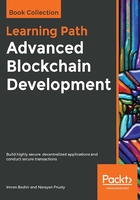
What this book covers
Chapter 1, Blockchain 101, introduces the basic concepts of distributed computing on which blockchain technology is based. It also covers history, definitions, features, types, and benefits of blockchains along with various consensus mechanisms that are at the core of the blockchain technology.
Chapter 2, Decentralization, covers the concept of decentralization and its relationship with blockchain technology. Various methods and platforms that can be used to decentralize a process or a system have also been introduced.
Chapter 3, Understanding How Ethereum Works, explains how Ethereum works.
Chapter 4, Smart Contracts, provides an in-depth discussion on smart contracts. Topics such as history, the definition of smart contracts, Ricardian contracts, Oracles, and the theoretical aspects of smart contracts are presented in this chapter.
Chapter 5, Symmetric Cryptography, introduces the theoretical foundations of symmetric cryptography, which is necessary to understand how various security services such as confidentiality and integrity are provided.
Chapter 6, Public Key Cryptography, introduces concepts such as public and private keys, digital signatures and hash functions with practical examples. Finally, an introduction to financial markets is also included as there are many interesting use cases for blockchain technology in the financial sector.
Chapter 7, Getting Started with web3.js, introduces web3js and how to import and connect to geth. It also explains how to use it in Node.js or client-side JavaScript.
Chapter 8, Introducing Bitcoin, covers Bitcoin, the first and largest blockchain. It introduces technical concepts related to bitcoin cryptocurrency in detail.
Chapter 9, Building a Wallet Service, explains how to build a wallet service that users can use to create and manage Ethereum Wallets easily, even offline. We will specifically use the LightWallet library to achieve this.
Chapter 10, Alternative Coins, introduces alternative cryptocurrencies that were introduced after the invention of Bitcoin. It also presents examples of different altcoins, their properties, and how they have been developed and implemented.
Chapter 11, Development Tools and Frameworks, provides a detailed practical introduction to the Solidity programming language and different relevant tools and frameworks that are used for Ethereum development.
Chapter 12, Building a Betting App, explains how to use Oraclize to make HTTP requests from Ethereum smart contracts to access data from the World Wide Web. We will also learn how to access files stored in IPFS, use the strings library to work with strings, and more.
Chapter 13, Hyperledger, presents a discussion about the Hyperledger project from the Linux Foundation, which includes different blockchain projects introduced by its members.
Chapter 14, Alternative Blockchains, introduces alternative blockchain solutions and platforms. It provides technical details and features of alternative blockchains and relevant platforms.
Chapter 15, Blockchain - Outside of Currencies, provides a practical and detailed introduction to applications of blockchain technology in fields others than cryptocurrencies, including Internet of Things, government, media, and finance.
Chapter 16, Scalability and Other Challenges, is dedicated to a discussion of the challenges faced by blockchain technology and how to address them.
Chapter 17, Building a Consortium Blockchain, will discuss consortium blockchain.
Chapter 18, Current Landscape and What's Next, is aimed at providing information about the current landscape, projects, and research efforts related to blockchain technology. Also, some predictions based on the current state of blockchain technology have been made.